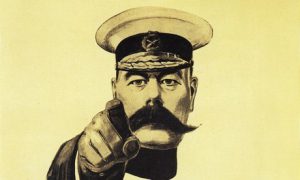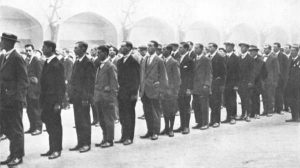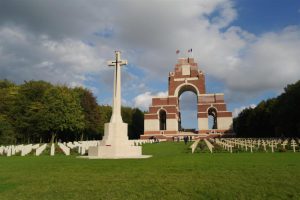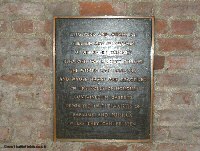At the outbreak of the first World War Herbert Henry Askwith was not only Prime Minister he was also the Secretary of State for War, which was not acceptable and so the position of Secretary of State for War was taken over by Horatio Herbert Kitchener, 1st Earl Kitchener. He inherited a greatly understaffed army because up to that time Britain relied upon its navy and did not see the need for great land forces.

On the 7th of August 1914 Kitchener started to recruit a new army called K1, consisting of 100,000 volunteers and he adopted the policy of those who joined together would serve together. This created ‘Pals Battalions’, which consisted of 1,000 men. A. L. Fisher who was Chancellor of the Sheffield University arranged for the University Officer Training Corps to parade in the city centre and recruit en-masse. Sheffield managed to form one battalion of 1,000 men whilst Barnsley managed to form two pals battalions. This was probably because the Sheffield battalion were referred to as toffs with white cuffs and shiny wrist watches.

The first parade was supposed to be at Norfolk barracks which was only designed for a few hundred men and so the parade was moved to the Sheffield United football ground at Bramhall Lane, much to the disgust of the groundsman, who was not pleased at seeing the ground churned up by several hundred drilling recruits.
The Sheffield Corporation quickly designed and built barracks to hold the recruits at Redmires which they occupied from the 5th December 1914 to the 15th August 1915. On the 31st July they went to Rippon for rifle training and from the 21st to 22nd of December they bordered HMT Malakoda to go to the Suez Canal as reinforcements. On the 16th March 1916 they were transferred to Marseilles in readiness for trench warfare in the Somme.
The object of the battle of the Somme was to relieve pressure on the French who were being attacked at Verdon, East of Paris. The objective of the battle was to make the Germans remove troops from Verdon and redeploy them as reinforcements along their front line on the Somme.
The battle was commanded by Field Marshal Sir Douglas Hague and General Henry Rawlinson over a 25 mile front. Field Marshal Hague wanted a heavy prolonged artillery bombardment followed by a surprise sweeping attack to gain as much ground as possible and to punch a hole in the German lines. General Rawlinson however wanted to attack in small bites and consolidate his position each time. Field Marshal Hague was in overall charge and so his plan was implemented. The German army consisted of 3 lines with very deep trenches and bomb proof shelters stretching back over several miles and Field Marshal Hague wanted to take two in one bite.
A week before the start of the battle the bombardment started and in all 1,738,000 shells were fired. During this period the Germans went down into the relative safety of their shelters and when the shelling stopped they came up ready to fight using machine guns which mowed the allied troops down. Hunter’s 8th corps 31st division contained the Sheffield Battalion and these occupied the most forward position in the line.

On the 1st of July 1916 the battle commenced and on the first day of the battle there were 57,000 British casualties and of those 19,200 were killed. The battle lasted 140 days and claimed 419,654 British, 204,253 French and 500,000 German casualties. This enabled the allied front line to move forward just 6 miles.

It is a sobering thought to compare these figures with the size of the British army today, which is a total of 144,900 troops made up of 89,860 regular, 25,010 army reserves and 30,030 regular reserves.
If nothing else this battle showed the total futility of trench warfare.
This short extract does not do justice to the very professional presentation by Anthony Bolton.
